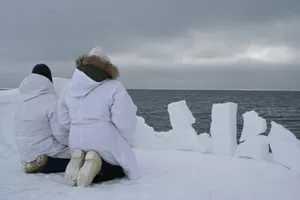Inuit forecasters equipped with generations of environmental knowledge are helping scientists learn something new about Arctic weather. A study published this month in the journal Global Environmental Change brings together two worlds, combining Inuit environmental knowledge with the practice of statistical weather analysis. The study, a collaboration between researchers at the National Snow and Ice Data Center (NSIDC) and the University of Colorado at Boulder's Cooperative Institute for Research in Environmental Sciences (CIRES), shows that including the observations and stories of the Inuit into climate research can not only provide valuable insights into asking the right scientific questions, but help researchers find new ways of answering them.
NSIDC researcher Shari Gearheard lives in Clyde River, Nunavut, Canada, an Inuit community on eastern Baffin Island, and for the past ten years has been working with Inuit hunters and elders to document their knowledge of the environment and environmental change. She worked with lead author, environmental statistician Elizabeth Weatherhead, to examine changes in weather patterns that Inuit have noticed in recent years. More and more, Inuit noticed changes during the spring, a time of transition for many environmental processes. "In fact in a lot of places, the name of the season is named after a particular process,"said Gearheard. "Inuit are not seeing that anymore, which was an indicator to them that something had changed."
What the researchers found was a scientific story more in line with what people were witnessing on the ground. Weather along the Arctic latitudes was behaving more unpredictably than in other parts of the world. "That's an incredibly important parameter to care about, incredibly important," said Weatherhead. "The way I try to describe it to some people, if we get an inch of rain out at my house in the month of July, I don't need to turn on the sprinklers. But if we get an inch of rain on July 1, and no rain after that, my lawn is dead."
NSIDC scientist Roger Barry, a CIRES fellow and director of the World Data Center for Glaciology at NSIDC was also an author on the paper.
Contact
Elizabeth Weatherhead, Betsy.Weatherhead@noaa.gov, +1 303.497.6653
CIRES communication, news@cires.colorado.edu, +1 303.492.6289
NSIDC communication, press@nsidc.org , +1 303.492.1497
